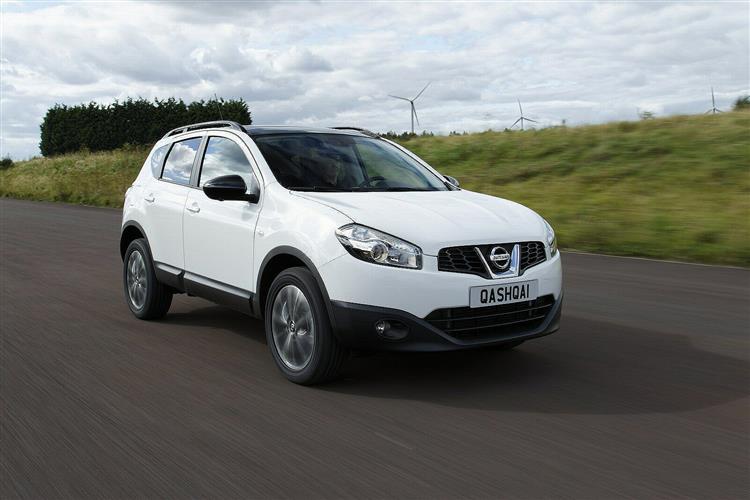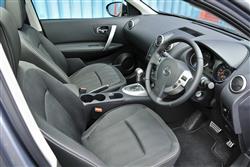QASHING IN (some text hidden) --NONE--
By Andy Enright
Introductionword count: 140
Pleasant surprises are always welcome. It's probably fair to say that Nissan probably didn't expect to radically change the way British buyers bought mid-range cars when it introduced the Qashqai back in 2007, but that's exactly what happened. Bored by a constant stream of family hatches and depressingly suburban compact SUVs, we loved the Qashqai. Nissan called it a crossover and that's exactly what it was, offering a blend of the qualities of family hatch and SUV. Still, Nissan needed to stay ahead of a chasing pack that jealously regarded its consistent top ten position in the UK sales charts. A whole host of copycat vehicles followed but in 2011, Nissan made a wide-ranging series of changes to the Qashqai, keeping it at the vanguard of the new breed of crossovers. Here's how to track down a good used one.
Modelsword count: 12
5dr Crossover (1.6, 2.0 petrol, 1.6, 2.0 diesel [Visia, Acenta, 360, Tekna])
Historyword count: 258
Nissan probably wins the award for most visionary car manufacturer of the past decade. Time and again it's managed to predict market trends and be there with the right product when the public gets with the program. The Qashqai is but the most obvious example, but cars like the Juke and the GT-R have also been massive hits. It's developed the theme along the way, never giving its opposition a static target to draw a bead on. In 2009 we saw an element of MPV versatility added to the mix with the seven-seater Qashqai+2 variant was launched. But of course, competitive brands were watching and by the beginning of 2010, the crossover market the Qashqai had created was filling out with competitors like Peugeot's 3008, BMW's X1 and Skoda's Yeti. Nissan responded with this heavily revised second generation model, a car that was smarter and cleverer. Launched in the Autumn of 2011, the big news with the updated Qashqai was under its bonnet. To support the underwhelming 1.5-litre dCi diesel, in came a 130bhp 1.6-litre dCi diesel that made all the right numbers when it came to real world performance, fuel economy and emissions. More importantly for Nissan, it put some distance between the Qashqai and the chasing pack. Cars like the Subaru XV and the Mazda CX-5 were posing a clear threat. Results talk though, and the Qashqai battered these very talented rivals in the sales charts, right through to its replacement at the end of 2013 with a car that was new from the ground up.
What You Getword count: 345
Designer Stephane Schwarz pulled it off and managed not to spoil a good thing by going too far with the mid-life 2010 facelift. He smartened up the bonnet, the front bumper, the wings, the front grille and the headlamps but overall, the effect remains much the same, if slightly more distinctive and up-market. It's a look continued around the back where there are subtle aerodynamic tweaks and LED lights. Up front, it feels much more spacious, especially in a version fitted with the full-length glass panoramic roof. You get the expected crossover-style high seating position, yet there's ample headroom - plus it's easy to find an ideal driving position courtesy of a height-adjustable driver's seat and steering tweakable for both reach and rake. Look around you and you won't observe the highest quality cabin in the class - that was a mission for Nissan in the 2014 car - but it is solidly built with detail improvements like low-level lighting around the front footwells and a smart instrument layout with a neat LCD driver information screen in the centre. The trim level range kicks off with the entry-level Visia before extending through the Acenta and N-Tec derivatives to the plush Tekna. The n-tec models are likely to prove particularly popular with their focus on technology built around Nissan Connect. Nissan Connect is a control system for the Qashqai's advanced technology features which brings Bluetooth connectivity, touch screen satellite navigation, a colour reversing camera, an MP3 compatible CD stereo and a USB interface for connecting MP3 players all together in a single interface. The n-tec models also get 18" alloy wheels, a panoramic glass sunroof, privacy glass, roof rails and an auto-dimming rear-view mirror. The Nissan Connect system also comes as standard with the Tekna models. The most noteworthy addition to the Tenka's standard kit list, however, is the Around View Monitor which adds three external cameras to the Qashqai's existing rear view system to create a 360 degree overhead view. It's essentially the same system used in Nissan's premium brand Infiniti EX and FX models.
To see the full road test text contact us on 0330 0020 227
Pictures (high res disabled)

.jpg)
|
.jpg)
|
.jpg)
| |||
.jpg)
|

|
Scoring (subset of scores)
Category: Crossover or SUV 4x4s
| Performance | |
| Handling | |
| Comfort | |
| Space | |
| Styling, Build, Value, Equipment, Depreciation, Handling, Insurance and Total scores are available with our full data feed. | |



